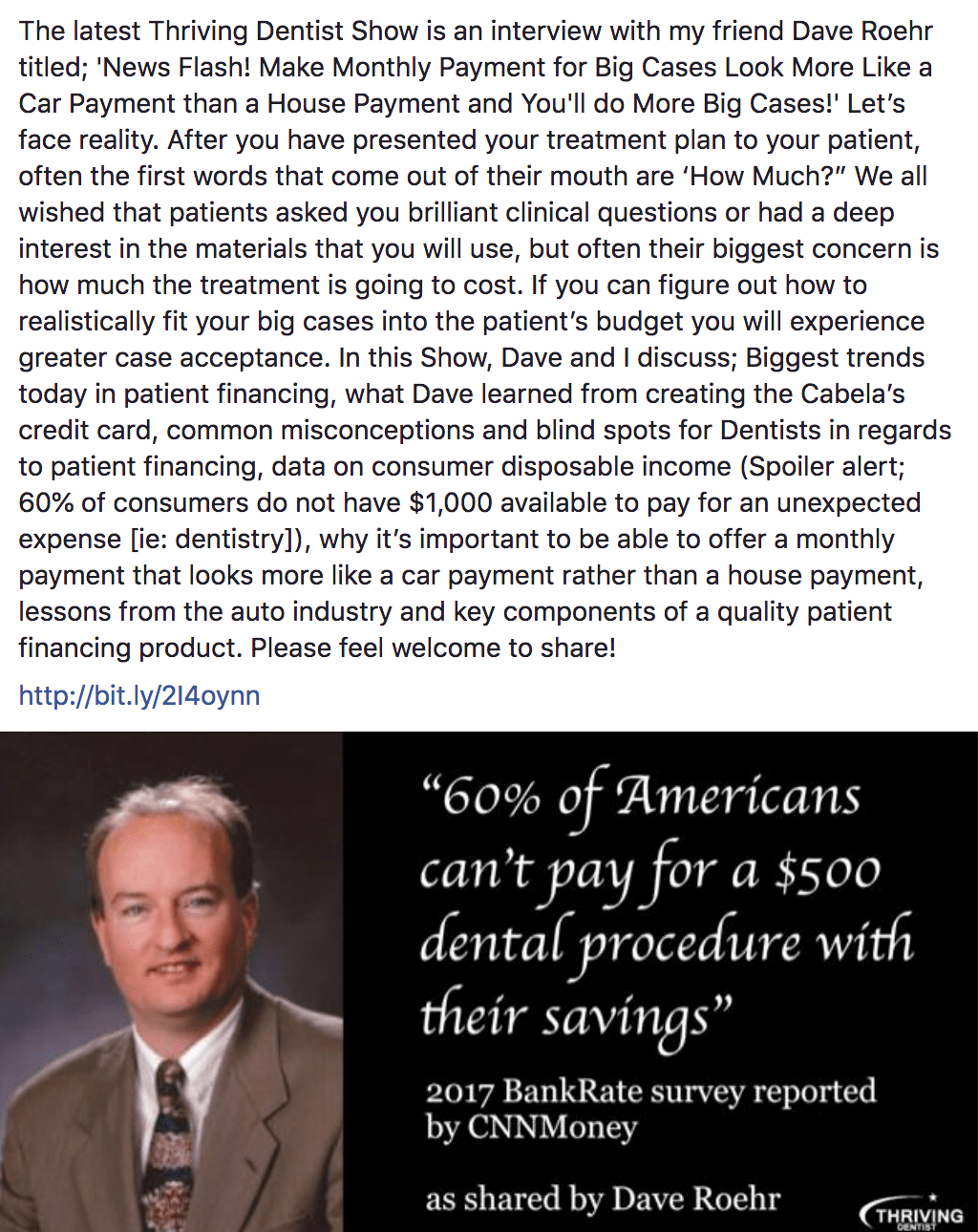In a recent Facebook thread, I found this post. Not at all surprising. In fact, it confirmed my view of how I see the dental business avoiding the real issue, which is increasing access to dental care.

The latest Thriving Dentist Show is an interview with my friend Dave Roehr titled: News Flash! Make Monthly Payment for Big Cases Look More Like a Car Payment than a House payment, and You’ll Do More Big Cases. Let’s face reality. After you have presented your treatment to your patient, often the first words out of their mouth are “How much?”….If you figure out how to really fit your big cases into the patient’s budget, you will experience greater case acceptance.…Biggest trends in patient financing.
—
I can understand the solution being proposed, given that the dental practices, solo or group, operate as a business, in a for-profit context. The solutions suggested generating greater case acceptance via various financing solutions that enable sustainable revenues by extending credit. Unfortunately, this solution will only have minimal impact on expanding access to care.
Any commercial solution will not be effective for the future, which is fast approaching: a future that demands much greater access to dentistry. Why? Because commercial solutions do not solve the access problem; they only solve the dentist’s problem.
The access problem is being addressed from the inside out: dentist to the public. “We’ll make it easier for you to pay for your dentistry.” The multitude of future influences from government, hospitals, insurance companies, and employers will dramatically increase to expand access. These influences are coming from the outside in, and when they come from the outside in, it shifts the entire context. And context is decisive.
Addressing the Access Problem in Dentistry
Forty-six percent of the population does not have access to dentistry. The older the population gets, the less access they have, largely due to cost. The United States has an aging population, and the upper end of the older population lives on a fixed income. Furthermore, the older the population, the greater incidence and severity of chronic medical issues. With the increasing cost of treating and managing chronic diseases on the increase, access to dentistry will soon become a critical public health concern.
How will dentistry respond? Dentistry will do the same dance around the issue that it has always done. But a public concern that goes unaddressed will soon turn into a political concern. A political concern turns into regulations and mandates. Rather than dentistry addressing the access issue from an industry perspective, it will apply local commercial solutions to protect practice cash flow — which is not a solution that will fix the access problem.
The demand for dentists to participate in patients’ primary care is unquestionably growing. The health care system will demand greater access to dental care as a point-of-service for primary care.
Changing the Dental Business Model
Dentists will soon be directly linked to electronic patient records and assigned responsibilities to perform certain diagnostic functions correlated with systemic disease detection and status. With the advent of AI, cloud computing, Big Data, and relational databases, dentistry will become much more embedded in primary care.
In 2016, health care costs in the United States were $3.3 trillion, making health care one of the country’s biggest industries at 17.9 percent of the GDP. In 1960, health care cost $27.2 billion, just 5 percent of GDP, which translates to an annual health care cost of $10,348 per person in 2016, versus just $146 per person in 1960.
Health care costs have risen faster than the annual income, and consumed 4 percent of income in 1960 compared to 6 percent in 2013. It’s trending higher, faster.
This big increase was caused by two things: government policy and changes in lifestyle. The United States relies on company-sponsored private health insurance, and the government created programs like Medicare and Medicaid to help those without insurance. These programs increased demand for healthcare services and gave providers the ability to raise prices. A Princeton University study concluded that Americans use the same amount of healthcare as residents of other nations, but they pay a lot more for it.
Chronic illnesses, such as diabetes and heart disease, have become more common. They are responsible for 85 percent of healthcare costs. Almost half of all Americans have at least one of these issues.
Dentistry is part of the healthcare system. Dentistry sees approximately 235 million patients a year, leaving about 134 million people with no access to a dentist. Uncontrolled oral inflammation increases the severity of diabetes and heart disease. Utilizing dentists in primary care to close the care gap will most certainly to help stay the costs of managing chronic diseases, which in turn will pressure dentistry to improve access significantly.
The fact is, dentistry pays lip-service to expand access. Dentistry’s primary focus is on revenue generation and profitability; dentistry exists within a for-profit context — as long as the schedule is full and dentists have enough patients to meet their economic needs, there is no impetus to figure out how to increase access. But the pressures from the stakeholders in healthcare, hospitals, insurers, employers, government, and patients, will soon force dentistry to confront the issues of access.
As Einstein said, “We cannot solve our problems with the same thinking we used when we created them.” Dentistry will be forced to re-engineer itself to solve the access problem.
— Marc



